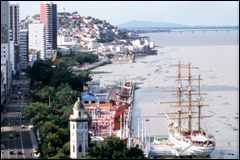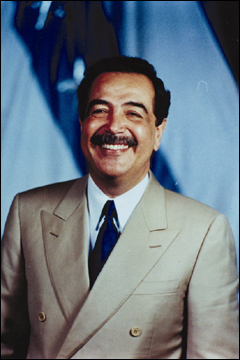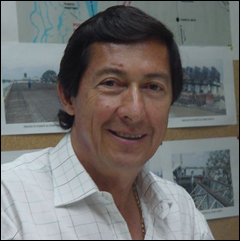|
 View this document
in Spanish.
View this document
in Spanish.
 THE COASTAL
HUB THE COASTAL
HUB |
Along the Pacific coast you will also find the
City of Guayaquil, Ecuador's
largest metropolis, known as the business capital
of the country. Being the main port of Ecuador
and the major economical center of the country,
Guayaquil has experienced a "boom" in
the last decade.
In fact, the city has had a major facelift; the
"Malecón 2000" project has changed
its image, inaugurating a modern complex of parks,
restaurants, museums and stores that has been
constructed along the riverfront of the Guayas
river in the downtown area of the city. Then the
historical neighborhood of Santa Ana has been
reconstructed, with painted houses with the style
of "El Caminito" of Buenos Aires, and
a new shopping center was opened last July, complete
with the high class brand name fashion stores.

This is part of the most ambitious urban regeneration
plan in Ecuador, led by the Mayor
of Guayaquil, Jaime Nebot. Today the public
works projects continue: this summer saw the inauguration
of a new underground tunnel, as well as the groundbreaking
of a new bridge which will facilitate heavy transport.
Meanwhile, hundreds of workers continue making
road improvements and renovations of downtown
streets, plazas and buildings.
"This urban regeneration is not only physical,
it has become an economic movement of the activities
within Guayaquil and in the entire country. It
has also generated employment for thousands of
people", said Nebot.

|
This ambitious political
leader considers that the municipal change is not
only physical, but it has brought value to the lives
of its citizens. The urban regeneration has changed
the way in which Guayaquileños see their
city and has also developed a tourist industry that
has positioned Guayaquil as a meeting point for
tourists going to the renown Galapagos islands.
But Nebot's plan is not limited to urban regeneration;
it harnesses the economical potential of the city
and its geographical location to become a convention
center of Latin America.
"Guayaquil is a city located in the middle
of America, in the middle of the world, at sea
level, near the Galapagos Islands, with a potential
to be a major center for international conventions",
said Nebot at the moment of explaining the vision
for his project to build a world class conventions
centre in the heart of Guayaquil.
Transport infrastructure is also a key factor
for the city's development. The expansion of the
airport and the dredging of the harbor is intended
to create a basic transport hub, while the improvement
of highways and roads that connects the city with
the country is meant to position Guayaquil in
a regional context.

Yet a regional policy also requires a regional
leader. This is Nicolas Lapentti,
Prefect of the Province of Guayas, a self-made
man who was asked to lead the province 11 years
ago and never looked back. He won the past three
elections and has forged strong ties with communities
and private companies to transform the region
into an export powerhouse.
His vision is simple: to prepare the region for
investors. "The Province of Guayas offers
the best road system of the country, with strategic
projects and an infrastructure that is unparalleled
in Ecuador. Whoever is interested in investing
in this country certainly has the best conditions
here in Guayas" adds Lapentti.
|

